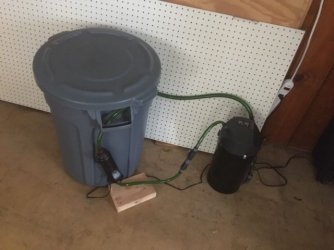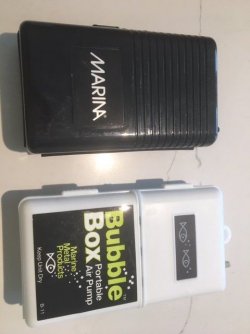FishBR
Fish Fanatic
Hi everyone,
I wanted to share with you some recommendations on how to prepare for power outages. I just went through hurricane Zeta and lost power for 3 days and 2 hours. This thread shares my experiences with only one tank: a low-tech, planted 55g tank with 10 juvenile rainbowfish (5 Boesemani and 5 Maccullochi), 5 Panda Garras, 2 Empire Gudgeons, and 6 Corydoras. The tank runs with a canister filter (Eheim 2217), and thus my experience does not help folks with other types of filtration. Anyway, here are my recommendation:
1. Make sure you have some battery-powered air pumps. They are awesome! My two pumps worked nonstop with two D-size batteries for more than 3 days. I was quite impressed.
2 Always have a sponge filter running in you tank. This will ensure that you will have biological filtration going after the power goes off. Just attach one of the battery-powered pumps to the sponge filter once you lose power.
3. Save the bacteria in your canister filter. If you go for a long period of time (more than a day) without running your canister, most likely all the beneficial bacteria will die. Hopefully, one of your friends or family members will get power back quickly and you can ask him/her a favor. Here is what I did. I brought my canister and a 20g bin to the house of a friend who had power. I filled the bin with dechlorinated water and attached the canister to the bin (see the picture below). Make sure you have some surface agitation so that you get well-oxygenated water. I then added 3ppm of ammonia to the bin so that the bacteria had food while the canister was running. Mare sure you use pure ammonia, with no additives. In the US, you can get this product from Dr. Tim:
https://store.drtimsaquatics.com/Ammonium-Chloride-Solution-for-Fishless-Cycling.html
It worked! After about 26 hours I came back to my friend’s house to test the water and got 0 (zero) ammonia and 0 (zero) nitrite. I then added ammonia again.
4. Get a hot water bottle. Temperature drop is a major problem. In my case, the tank’s temperature dropped from 77 F (25 C) to 65 F (18 C) in 3 days (the hurricane was followed by a cold front). The temperature did not drop more because I started using a hot water bottle. I just filled the bottle with hot water and floated it in the tank. Important: after the power comes back, increase the tank’s temperature slowly. Remember that the temperature dropped slowly, so It should come back slowly.
5. Do not feed the fish while all this is going on. You want hungry fish, not fish poisoned by ammonia.
So, things you must purchase in advance:
- Battery-powered air pumps
- Batteries
- Airline and air stones
- A water container or plastic trash bin
- Pure ammonia (ammonium chloride)
- Hot water bottle
I hope my experience will help others get prepared.
I wanted to share with you some recommendations on how to prepare for power outages. I just went through hurricane Zeta and lost power for 3 days and 2 hours. This thread shares my experiences with only one tank: a low-tech, planted 55g tank with 10 juvenile rainbowfish (5 Boesemani and 5 Maccullochi), 5 Panda Garras, 2 Empire Gudgeons, and 6 Corydoras. The tank runs with a canister filter (Eheim 2217), and thus my experience does not help folks with other types of filtration. Anyway, here are my recommendation:
1. Make sure you have some battery-powered air pumps. They are awesome! My two pumps worked nonstop with two D-size batteries for more than 3 days. I was quite impressed.
2 Always have a sponge filter running in you tank. This will ensure that you will have biological filtration going after the power goes off. Just attach one of the battery-powered pumps to the sponge filter once you lose power.
3. Save the bacteria in your canister filter. If you go for a long period of time (more than a day) without running your canister, most likely all the beneficial bacteria will die. Hopefully, one of your friends or family members will get power back quickly and you can ask him/her a favor. Here is what I did. I brought my canister and a 20g bin to the house of a friend who had power. I filled the bin with dechlorinated water and attached the canister to the bin (see the picture below). Make sure you have some surface agitation so that you get well-oxygenated water. I then added 3ppm of ammonia to the bin so that the bacteria had food while the canister was running. Mare sure you use pure ammonia, with no additives. In the US, you can get this product from Dr. Tim:
https://store.drtimsaquatics.com/Ammonium-Chloride-Solution-for-Fishless-Cycling.html
It worked! After about 26 hours I came back to my friend’s house to test the water and got 0 (zero) ammonia and 0 (zero) nitrite. I then added ammonia again.
4. Get a hot water bottle. Temperature drop is a major problem. In my case, the tank’s temperature dropped from 77 F (25 C) to 65 F (18 C) in 3 days (the hurricane was followed by a cold front). The temperature did not drop more because I started using a hot water bottle. I just filled the bottle with hot water and floated it in the tank. Important: after the power comes back, increase the tank’s temperature slowly. Remember that the temperature dropped slowly, so It should come back slowly.
5. Do not feed the fish while all this is going on. You want hungry fish, not fish poisoned by ammonia.
So, things you must purchase in advance:
- Battery-powered air pumps
- Batteries
- Airline and air stones
- A water container or plastic trash bin
- Pure ammonia (ammonium chloride)
- Hot water bottle
I hope my experience will help others get prepared.
Attachments
Last edited:


